Club de Gimnasia y Esgrima La Plata
Club de Gimnasia y Esgrima La Plata (Spanish pronunciation: [ˈkluβ ðe ximˈnasja i ezˈɣɾima la ˈplata]; English: La Plata Gymnastics and Fencing Club), also known simply as Gimnasia or the acronym CGE, is a professional Argentine sports club based in the city of La Plata, Buenos Aires Province. Founded in 1887 as "Club de Gimnasia y Esgrima",[3] the club is mostly known for its football team, which currently plays in the Primera División, the first division of the Argentine football league system. The club is currently managed by Diego Maradona.
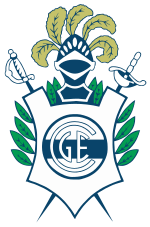 | |||
| Full name | Club de Gimnasia y Esgrima La Plata | ||
|---|---|---|---|
| Nickname(s) | El Lobo (The Wolf) Los Triperos (The gut-handlers)[1] | ||
| Short name | CGE | ||
| Founded | 3 June 1887 | ||
| Ground | Estadio Juan Carmelo Zerillo, La Plata, Argentina | ||
| Capacity | 21,500[2] | ||
| President | Gabriel Pellegrino | ||
| Manager | Diego Maradona | ||
| League | Primera División | ||
| 2018–19 | 18th | ||
| Website | Club website | ||
|
| |||
| Active departments of Gimnasia y Esgrima (LP) | |||||||||||||||||||||||||||||||||
|---|---|---|---|---|---|---|---|---|---|---|---|---|---|---|---|---|---|---|---|---|---|---|---|---|---|---|---|---|---|---|---|---|---|
|
Apart from football, CGE also hosts other activities such as athletics, basketball, fencing, futsal, gymnastics, field hockey, martial arts, tennis, roller skating and volleyball.[4]
History
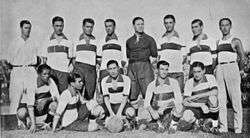
The "Club de Gimnasia y Esgrima La Plata" was founded on 3 June 1887 as a civil association, and thus is the oldest surviving football club still participating in the Argentine league. The club also claims to be the oldest football club in the Americas,[5][6] despite other football clubs, such as Peruvian Lima Cricket F.C., having older foundation dates. Its foundation came barely five years after the creation of the City of La Plata in 1882.[7]
The first sports offered to its members were, as its Spanish name indicates, gymnastics and fencing. Clubs supporting these sports were common among the upper classes at the end of the 19th century (cf. the prior foundation of Gimnasia y Esgrima de Buenos Aires in 1880). Later on, other disciplines were added, including track and field, football, basketball and rugby.[8]
The institution changed name a few times: from April to December 1897 it was called a "Club de Esgrima" (in English, "Fencing Club") because fencing was the only activity practised at that moment. On 17 December 1897 it returned to its original name: "Club de Gimnasia y Esgrima" ("Gymnastics and Fencing Club"). From July 1952 to 30 September 1955, the club was named "Club de Gimnasia y Esgrima de Eva Perón" ("Gymnastics and Fencing Club of Eva Perón"), because the city of La Plata itself had been renamed "Eva Perón" in 1952, after Eva Perón's death. The city returned to its previous name during the government of the "Liberating Revolution", and so did the club. However, it remained unduly identified legally as "Club de Gimnasia y Esgrima de La Plata" ("Gymnastics and Fencing Club of La Plata"), a mistake that was corrected on 7 August 1964 after the new statute was approved.[3]
Gimnasia y Esgrima was promoted to the first division after becoming champions of the División Intermedia of Argentine football in 1915. Later, in 1929, the club won its first Primera División championship. During successive years, Gimnasia became champion of Primera B in 1944, 1947 and 1952 and won the Copa Centenario de la AFA in 1994. Additionally, the squad has been a runner-up in the Primera División on five occasions.[1][9][10] The club has remained at the top level of Argentine football for 73 seasons, giving it with Newell's Old Boys the eighth longest participation at this level.
Clásico Platense
The Clásico Platense (La Plata derby) is the nickname given to the match between La Plata's two main football teams: Gimnasia y Esgrima La Plata and Estudiantes de La Plata. The first official derby took place as part of the Primera División season on 27 August 1916. On that occasion, Gimnasia won 1–0 over Estudiantes, with an own goal by Ludovico Pastor.[11]
The first derby of the professional era took place on 14 June 1931. Between 12 August 1932 and 9 September 1934 Gimnasia won five consecutive La Plata derbies, the longest run of victories in that derby until Estudiantes emulated that feat in 2006–08. On 25 June 1963 Gimnasia obtained a 5–2 victory, this being the best result so far against Estudiantes. On the other hand, Gimnasia's worst result was a 7–0 defeat on 15 October 2006.[12]
A curiosity among the derbies occurred on 5 April 1992, when Gimnasia won over Estudiantes 1–0 at the latter's stadium. On that date, as the stands erupted and Gimnasia's fans shouted in celebration at the goal being scored, the seismograph of the local Astronomical Observatory registered a low-intensity seismic event. That goal was scored by the Uruguayan José Perdomo on a freekick, and it has been known ever since as "El gol del terremoto" ("The earthquake goal").[13][14]
Presidents
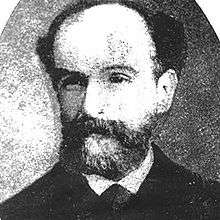
Through more than 120 years of history, the Club de Gimnasia y Esgrima La Plata has had 56 Presidents, who are elected individuals who took on the responsibility of steering the Institution. Many of them contributed to the growth of the club over the years. Some of them have remained more vivid in the fans' memory for their achievements or outstanding works.[1]
Saturnino Perdriel was the founder and first president of Gimnasia y Esgrima La Plata. Perdriel was a merchant during the first few years of the city of La Plata, in addition to being a civil servant at the Treasury Department of the Province of Buenos Aires. He died prematurely in 1888, after one year as Club president.[1]
Currently, the President of Club de Gimnasia y Esgrima La Plata is chosen by its associates, by means of general elections that take place every three years.[15] Any club member over 18 years of age, and with at least three years membership of the Club, have a right to vote. Members with over seven years membership have a right to be elected to the Club governmental body, the Management Commission or "Directory".
The most recent President of Gimnasia y Esgrima La Plata is Gabriel Pellegrino, who refused to run for re-election in 2019.[16][17][18] On December 15, 2019, however, Pellegrino, who was encouraged to seek re-election from club manager Diego Maradona, was re-elected to a three-year term.[19]
Facilities
Gimnasia's facilities include, besides its football stadium, a campus of 160 hectares, a campus for children's football, a sports center, a kindergarten, a primary school and one high school. There are also dozens of subsidiaries located in the country and the world.
- Estadio Juan Carmelo Zerillo: also known as El Bosque (Spanish for "the forest", because it is located in the La Plata park of the same name), has the capacity to accommodate approximately 24,544 spectators.
- Estancia Chica: It is a property of 160 hectares, where the professional football team trains before each match.
- El Bosquecito: It is a campus of 11 hectares where children's categories practice and play.
- Other: The club has opened a kindergarten in 1999 (works on Calle 62 No. 474), a Primary School called "Dr. René Favaloro" opened in 2001 (on streets 123 and 58) and a High School opened in early 2008.[20][21]
- Polideportivo Gimnasia y Esgrima La Plata: Opened in 1978, Gimnasia y Esgrima has a sports complex, where it competes in the first division of basketball and volleyball with a capacity for 2,600 people, which rises to 3,500 spectators when performing musicals.
- Headquarters: In addition to the administration of the club and the attention of the members, it is possible to play sports like basketball and volleyball, among others. It also has a gym.
Anthem
The official anthem of Gimnasia was written in 1915 by the popular poet born in Magdalena, Délfor B. Méndez and the music was composed by the master Juan Serpentini, who composed versions of the National Argentine Anthem and "El tambor de Tacuarí", with Rafael Obligado's letter.
The official anthem of Gimnasia was intoned by the first time on 9 July 1915 on the occasion of the reception that was given to the delegation of the club River Plate of Uruguay. In 1967 the official anthem was recorded by the musical ensemble of the Buenos Aires Police.
Emblems and colors
Badge
The shield of the Club de Gimnasia y Esgrima La Plata is a wreath in which, in the top part, a helmet is outlined with a heraldic crest. At the center, on enamel and with the colors of the club (white and navy blue), is the club monogram appears. In the top cantons, like a guard, there appears the hilts of a saber and a foil, with their sharp points emerging in lower part of the shield. To the sides of the center laurels spread around the helmet.[1][22]
Since its inception, the club shield has undergone some modifications. The first symbol of the club appeared on a document dated 30 April 1888. This emblem consisted in the coat of arms of La Plata with the legend "Club de Gimnasia y Esgrima La Plata – Mens Sana in Corpore Sano" surrounding it.
But the first new crest was indeed devised in 1900 by Emilio Coutauret, which was characterized by a handcrafted and adorned design. Because this symbol could not be reproduced easily at small sizes, the club commissioned technical draftsman Raúl Felices to design a more synthetic emblem. As a result, a new symbol was released in 1928. It has remained until present days.[23]
During Héctor Domínguez's presidency, the abbreviation CGE (Club de Gimnasia y Esgrima) at the center of the shield was replaced by GELP (Gimnasia y Esgrima La Plata). Since the beginning of Walter Gisande's presidency, it was decided to return to the original abbreviation of 'CGE'.[1]
Uniform
The official historical uniform of Gimnasia y Esgrima is based on the colours displayed in the club shield, as established in the institutional statute, a white jersey with a single horizontal navy-blue stripe over the chest.
In the first years of the institution, the colors adopted were white and light blue, seeking to highlight the fact that it was an Argentine club. The first vest used by the team had vertical white and light blue stripes.[24]
In 1905, it was decided to change the colors to make it distinct from Racing Club. This resulted in a vest with vertical stripes of white and navy-blue color.[24]
Finally, in 1910, the design was modified, changing the vertical stripes into the horizontal band of navy-blue color over a white jersey, which has been used ever since.[25]
Uniform evolution
1903 |
1905 |
1910–present |
Apparel and sponsors
The table below details the companies that provided the team's apparel, and have been sponsoring the club since 1980 to date:
|
|
|
Supporters

Fan base
Within the city of La Plata and its environs, Gimnasia's fan base used to be identified with the working class, in contrast with the mostly middle class Estudiantes' constituency. Most of Gimnasia y Esgrima fans are from the Greater La Plata area.
The barra brava section named itself "La 22", after 22nd street in La Plata where many famous violent fans lived, notably Marcelo Amuchástegui. Known as Loco Fierro, Amuchástegui was famous for his exploits, such as hanging a 100-meter Gimnasia flag in the Bombonera stadium. He was shot to death by Rosarian police in a murky episode on 28 May 1991, allegedly during an armed robbery.[1][39]
As is the case with other clubs in the Argentine First Division, the fans celebrate the "Worldwide Day of Gimnasia's Fans" on 10 December with a large party and outside gathering.[40][41][42]
Nicknames
Since the 1960s, Gimnasia has been known as El Lobo (short for "El Lobo del Bosque", Spanish for "the wolf in the Forest") after the story of "Red Riding Hood", since its historical football field is located in the middle of La Plata's main park, known as El Bosque ("the forest").[43] Another nickname, mensanas, derives from the Latin motto used in the shield: Mens sana in corpore sano (a healthy mind in a healthy body).[44]
An original nickname was (and still is) triperos ("tripe" or "gut-handlers"). This name has its origin in the fact that many of Gimnasia's original supporters worked in the meat-processing plants of nearby Berisso. In newspaper caricatures from the early 1900s, Gimnasia was accordingly depicted as a "butcher", instead of the current "wolf". However, Gimnasia is still often greeted by its fans with a resounding "Tripa corazón!" (Spanish for "Heart of tripe!"). Curiously, the same nickname is applied when referring to the population of Porto in Portugal, although the meaning of the nickname in Portuguese is closer to "tripe-eaters".[43]
Another nickname is basureros ("garbage or waste collectors"), acquired during the presidency of Mr. Venturino in the 1970s, who also managed the private company dealing with trash pickup in La Plata.[43][45]
Stadium
The Juan Carmelo Zerillo stadium, known as El Bosque (Spanish for "the forest", because it is located in the La Plata park of the same name) had a capacity of 31,460 and was used continuously until 2005.
When a new city stadium was built for La Plata, both Gimnasia and Estudiantes initially chose to stay at their respective fields, but this arrangement collapsed when both fields were closed down due to new security regulations. In the 2006 Clausura tournament, Gimnasia began to use the city stadium for home games.[46]
Beginning in March 2008, Gimnasia made various reforms to its old stadium, seeking to secure the permit for its use at selected games. Finally in June 2008, the "El Bosque" grounds were reapproved for First Division competitions. On Saturday 21 June 2008, in the last game of the Clausure 2008 championship, Gimnasia returned to its old home in a match against Lanús.[47][48] Now the Juan Carmelo Zerillo stadium has a capacity of 24,544.
Team records
- Largest victories:
- 10–1 to River Plate (in 1905 playing in the División III)
- 8–1 to Racing Club (22 November 1961)[49]
- In international tournaments: 5–1 to Alianza Lima (at the Copa Libertadores 2003)[50]
- Most consecutive victories:
- 8 (Apertura 2005) The 6th-best in the history of Argentina football.[51] (in small tournaments)
- 9 (1962)
- Worst defeats:
- In national championships: 0–8 to Huracán.[1][1][3]
- In international tournaments: 0–4 to IA Sud América (at the Copa Conmebol 1995)
- Participation in international competitions:
- Copa Conmebol (3): 1992 (being a Semi-Finalist), 1995[52] and 1998.[53]
- Copa Sudamericana (2): 2002 and 2006 (reached the Round of Eight).[1]
- Copa Libertadores (2): 2003 and 2007.
Players
In its 121-year history, the team has had more than 800 players play for their first team. From its low divisions they have arisen a great quantity of football players of national and international renown, as being Guillermo and Gustavo Barros Schelotto, Mariano Messera, Lucas Lobos, Roberto "Pampa" Sosa, Andrés Guglielminpietro, Sebastián Romero, Lucas Licht, Hernán Cristante and Leandro Cufré, among others.[1]
Current squad
- As of 3 August 2019.[54]
Note: Flags indicate national team as defined under FIFA eligibility rules. Players may hold more than one non-FIFA nationality.
|
|
Out on loan
Note: Flags indicate national team as defined under FIFA eligibility rules. Players may hold more than one non-FIFA nationality.
|
|
Individual records
Most appearances
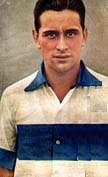
| Rank | Player | Marches | Period |
|---|---|---|---|
| 1 | 462 | 1992–2003, 2004–2009 | |
| 2 | 383 | 1991–2003 | |
| 3 | 343 | 1932–1945 | |
| 4 | 321 | 1990–2004 |
Top scorers
| Rank | Player | Goals | Matches |
|---|---|---|---|
| 1 | 95 | 97 | |
| 2 | 80 | 201 | |
| 3 | 71 | 138 | |
| 4 | 64 | 113 |
Managers
Since the beginning of the professional era, the Club Gimnasia y Esgrima La Plata has had a total of 63 managers (coaches). The first one was Emérico Hirschl, a Hungarian who trained the team between 1932 and 1934.[1][3]
Several prominent coaches for the team have been Nito Veiga (who led the team to promotion in 1984), Roberto Perfumo (who was coach in the final of the Centenary Cup), Carlos Timoteo Griguol (who led the team for ten years) and former footballer Pedro Troglio.
On 30 September 2008, the Club de Gimnasia y Esgrima La Plata hired Leonardo Madelón as manager.[55]
|
|
Other sports
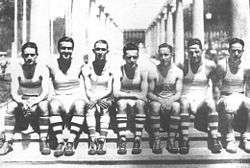
Basketball was practiced for the first time at the club in the 1920s. In 1924 the institution built a stadium on the corner of 60 and 118 streets. Since that time, it would become one of the major sports in the club.[56]
The basketball team peaked during the 1978 and 1979 campaigns, when it won two Metropolitano championships.[57] In both cases, team prevailed over favorite Obras Sanitarias, Argentina's powerhouse at the time. The team included players such as "Gallego" González, "Finito" Gehrmann, Peinado, as well as some Americans: Michael Jackson, Lawrence Jackson Jr., and the team leader and star, point-guard Clarence Edgar Metcalfe, chosen as the league MVP in 1979. The twice-champions were coached by Rolando Sfeir.[57][58]
Gimnasia was also runner-up in the 2003–04 Liga Nacional de Básquetbol's Primera División tournament, when it was defeated by Boca Juniors by 4–2 in the final series.[59][60]
In the following season, the team was relegated to the TNA (Second Division) after president Juan José Muñoz decreased substantially the basketball budget, thereby causing the loss of its principal players.[61]
Some of Gimnasia's notable basketball players were Carlos "Gallego" González, Ernesto "Finito" Gehrmann, Roberto López, Carlos Bejarano and Mariano Cerutti among others. Likewise, club's notable coaches include José Ripullone, Miguel Ángel Ripullone and Gonzalo García.
Gimnasia y Esgrima also has a female volleyball team, who are the only one of the nine founder clubs from the Federación de Voleibol y Pelota al Cesto,[62] still playing volleyball and in the highest division. The federation is current Federación Metropolitana de Voleibol (FMV).[63]
Former sports
In addition to the aforementioned sport activities, Gimnasia y Esgrima La Plata participated in other disciplines throughout its history. The following sports are no longer practiced in the club:
- Rugby union: In 1933, the "Unión de Rugby del Río de la Plata" (current Unión Argentina de Rugby) decided not to allow the affiliation of clubs that participated professionally in other sports (e.g., association football). As a result, the mens sana team playing rugby was forced to rename itself distinctly as "Gimnasia y Esgrima La Plata Rugby Club". Four years later, however, it was decided to channel rugby activities through an independent institution, thereby creating "La Plata Rugby Club",[64] which currently competes in the Torneo de la URBA, first division of the Unión de Rugby de Buenos Aires.
- Table tennis: The "Asociación Platense de Tenis de Mesa" ("La Plata Association for Table-tennis", part of the Argentine Federation of the sport) existed between 1945 and 1951. Gimnasia was a founding member of the Association, and it obtained the majority of the tournaments organized during these six years.
- Greco-Roman wrestling: Between 1924 and 1928 the club had a team of Greco-Roman wrestling.
- Gymnastics: During the 1930s, the practice of gymnastics played a central role in the club's activities. Members of the Gimnasia team were part of the Argentine delegation that competed in the 1936 Berlin Olympic Games. This discipline was discontinued after 1976.[57]
Other activities were available at the club at various periods, namely: water polo, boxing, cycling, pétanque, auto racing and judo, among others.
Honours
Football
- Official
- Primera División (1): 1929 [65]
- Copa Centenario de la AFA (1): 1993 [66]
- Primera B (3): 1944, 1947, 1952 [67][68][69][70]
- División Intermedia (1): 1915
- Copa Bullrich (1): 1915
- Friendly
- Copa Amistad (2): 1977, 2006
- Copa Ciudad de Mar del Plata (1): 2009
- Copa Municipalidad de La Plata (2): 1999, 2001
- Copa Gobernador Alende (1): 1960
- Copa Colonia del Sacramento (1): 1998
- Cuadrangular de Asunción (1): 1975
- Copa San Martín de Tours (1): 1973 [lower-alpha 1]
- Copa Cristal (1): 2005
Basketball
- Federación de Capital Federal's League (3): 1937, 1978, 1979, 1984, 1985
- Campeonato Argentino de Clubes (2): 1979, 1980
- Asociación Platense de Básquetbol's League (13): 1958, 1961, 1962, 1963, 1965, 1966, 1967, 1968, 1969, 1970, 1971, 1972, 1973
- Torneo Nacional de Ascenso (1): 2000–01
- Copa "Ismael Genaro Cerisola" (1): 1996[72]
Women's Volleyball
- Major honours
- Argentine Women's Volleyball National League::
- Federación Metropolitana: 1
- 2000 [76]
- Liga Metropolitana: 1
- 2004
- Friendly honours
- Copa Morgan (1): 1951,
- Torneos Evita (1): 1954
- Torneo Lola Berta (1): 1955
- Torneo Cuadrangular Chile (1): 1972,1975,
- Torneo Cuadrangular Náutico de Uruguay (1): 1976,
- Torneo Norma Rimoldi (1): 2005[77]
See also
- History of Club de Gimnasia y Esgrima La Plata (Football)
- Presidents of Club de Gimnasia y Esgrima La Plata
- Estadio Juan Carlos Zerillo
- La Plata derby
Bibliography
- Gimnasia y Esgrima La Plata, 100 Años, by Carlos Asnaghi. Publisher: Editorial Ceyne (1988) – ISBN 978-950-9871-04-5
- Gimnasia: Historia de una Pasión, by Héctor Collivadino. Publisher: Editorial Deportiva Bonaerense y Diario El Día (2005) – ISBN 987-43-0446-4
- Asociación del Futbol Argentino: Cien Años con el Fútbol, by Beto Devoto. Publisher: Manrique Zago Ediciones (1993) – ISBN 978-950-9517-40-0
- 140 Años de Fútbol Argentino, by Diego Estévez. Publisher: Edición del Autor (2009) – ISBN 978-987-05-5872-9
- Yo, el Basurero, by Aníbal Guidi & Oscar Venturino. Publisher: Editorial Universitaria de La Plata (2005) – ISBN 978-987-595-012-2
- La Barrabrava: Fútbol y Política, by Gustavo Veiga. Publisher: Grupo Editorial Agora (1998) – ISBN 978-987-96235-3-4
Notes
- The matches of this cup belonged to the Primera División championship. From 1963 to 1985 it was played between the team best placed and its rival.[71]
References
- Gimnasia: Historia de una Pasión, by Héctor Collivadino. Publisher: Editorial Deportiva Bonaerense & Diario El Día (2005) – ISBN 987-43-0446-4
- "CLUB DE GIMNASIA Y ESGRIMA LA PLATA". www.gimnasia.org.ar. Archived from the original on 15 March 2015. Retrieved 17 April 2018.
- Gimnasia y Esgrima La Plata, 100 Años, by Carlos Asnaghi, Editorial Ceyne, 1988 – ISBN 978-950-9871-04-5
- Deportes Archived 26 April 2015 at the Wayback Machine on club website
- "Campeón Centenario" (in Spanish). Letra G. Archived from the original on 23 July 2011. Retrieved 14 March 2009.
- "Argentina - Foundation Dates of Clubs". www.rsssf.com. Retrieved 17 April 2018.
- "Orígenes históricos de la fundación de La Plata" by Fernando Barba Archived 22 March 2009 at the Wayback Machine, El Día, 20 March 2009
- "CLUB DE GIMNASIA Y ESGRIMA LA PLATA". www.gimnasia.org.ar. Archived from the original on 17 April 2018. Retrieved 17 April 2018.
- "Final Tables Argentina Second Level 1935-2006/07". www.rsssf.com. Retrieved 17 April 2018.
- "CLUB DE GIMNASIA Y ESGRIMA LA PLATA". www.gimnasia.org.ar. Archived from the original on 22 March 2018. Retrieved 17 April 2018.
- "El fútbol en La Plata" on LaPlataMagica.com.ar
- "Gimnasia se dio el mayor de los gustos: pasó por encima a Estudiantes", Clarín, 13 June 2005
- "Perdomo: el fútbol uruguayo está en decadencia", El Gráfico
- "Estos ya conocen el paño", Olé, 13 Feb 2007
- "Estatuto Social" (in Spanish). Gimnasia.org.ar. Archived from the original on 20 August 2009. Retrieved 15 March 2009.
- https://www.theguardian.com/football/2019/nov/22/diego-maradona-stays-as-gimnasia-manager-following-outcry-by-fans
- https://uk.reuters.com/article/uk-soccer-argentina-maradona/maradona-to-stay-on-at-gimnasia-idUKKBN1XV2NE
- https://sports.yahoo.com/maradona-returns-gimnasia-head-coach-095808541.html
- http://www.xinhuanet.com/english/2019-12/16/c_138634325.htm
- "Se inaugura la secundaria" (in Spanish). Letra G. 2008. Archived from the original on 15 February 2009. Retrieved 18 March 2009.
- "Nueva escuela en Gimnasia" (in Spanish). Letra G. 2008. Archived from the original on 16 December 2008. Retrieved 18 March 2009.
- "GELP – Estatuto Oficial – Capitulo 1" (in Spanish). Gimnasia.org.ar. Archived from the original on 24 September 2015. Retrieved 13 February 2009.
- "CLUB DE GIMNASIA Y ESGRIMA LA PLATA". www.gimnasia.org.ar. Archived from the original on 17 April 2018. Retrieved 17 April 2018.
- "Historia de la albiazul" (in Spanish). Gimnasia.org.ar. Archived from the original on 23 March 2009. Retrieved 20 March 2009.
- Angelo, Clerici. "Club de Gimnasia y Esgrima La Plata". RSSSF. Retrieved 13 February 2009.
- "¿Quién vestirá al Lobo?" (in Spanish). Diario El Día. 2008. Retrieved 13 February 2009.
- "Historia de la Albiazul" (in Spanish). Gimnasia. 2009. Archived from the original on 19 January 2009. Retrieved 13 February 2009.
- "Números que dan escalofríos" (in Spanish). El Día. 1998. Archived from the original on 29 June 2012. Retrieved 13 February 2009.
- "Apuntamos a un Gimnasia campeón" (in Spanish). El Día. 1998. Archived from the original on 29 June 2012. Retrieved 13 February 2009.
- "Kappa vestirá a Gimnasia por dos años desde enero" (in Spanish). Cielo Sports. 2008. Retrieved 13 February 2009.
- "Nuevas camisetas Kappa 2009 de Gimnasia y Esgrima de La Plata" (in Spanish). Arte y Sport. 2008. Archived from the original on 29 January 2009. Retrieved 13 February 2009.
- "Los sponsors que no llegan" (in Spanish). Diario El Día. Archived from the original on 29 July 2012. Retrieved 13 February 2009.
- "Visto y oído en el Bosque platense" (in Spanish). Diario El Día. 2001. Archived from the original on 29 June 2012. Retrieved 13 February 2009.
- "Nuevo sponsor" (in Spanish). Diario El Día. 2002. Archived from the original on 29 June 2012. Retrieved 13 February 2009.
- "Nuevo sponsor" (in Spanish). Diario El Día. 2005. Archived from the original on 29 June 2012. Retrieved 13 February 2009.
- "Los sponsors" (in Spanish). Diario El Día. 2007. Archived from the original on 29 June 2012. Retrieved 13 February 2009.
- "Apuran por el Sponsor" (in Spanish). Diario El Día. 2008. Archived from the original on 29 June 2012. Retrieved 13 February 2009.
- "Nuevo sponsor:Rapicuotas" (in Spanish). Alma Tripera. 2010. Retrieved 13 February 2009.
- "Murió un conocido barrabrava del Lobo", El Día, 8 June 2001
- Allan, Juan Manuel (2006). "Fue un lobazo" (in Spanish). Diario Olé. Retrieved 30 June 2008.
- "Día del hincha" (in Spanish). Edición Nacional. 2005. Retrieved 30 June 2008.
- "Una fiesta bien tripera" (in Spanish). Diario Olé. 2004. Retrieved 29 June 2008.
- "Los apodos, una marca registrada" (in Spanish). Diario El Día. 2007. Archived from the original on 9 December 2012. Retrieved 30 June 2008.
- Mens sana in corpore sano Juvenal. Spirit balanced in a sensible body.
- Guidi (2005). Oscar Emir Venturino : yo, el basurero. p. 25.
- "Muñoz va y viene y ahora Gimnasia jugará en el Estadio Único" (in Spanish). Diario El Día. 2006. Archived from the original on 11 December 2008. Retrieved 29 June 2008.
- "Nada mejor que casa" (in Spanish). Letra G. 2008. Archived from the original on 31 December 2008. Retrieved 29 June 2008.
- "No hay nada mejor que casa" (in Spanish). Diario El Día. 2008. Archived from the original on 5 February 2009. Retrieved 29 June 2008.
- "Argentina – Domestic Championship 1961". RSSSF. 2007. Retrieved 29 June 2008.
- Rueda, Mario (2003). "Una goleada para soñar" (in Spanish). Diario Clarín. Retrieved 29 June 2008.
- "Record de victorias" (in Spanish). Universo Fútbol. 2003. Retrieved 29 June 2008.
- Andrés, Juan Pablo (2003). "Copa Conmebol 1995". RSSF. Retrieved 20 March 2009.
- Gonzalez, Miguel Alvim (1999). "Copa Conmebol 1998". RSSF. Retrieved 20 March 2009.
- "Gimnasia y Esgrima squad". Soccerway. Retrieved 7 October 2018.
- "Madelón es el nuevo entrenador de Gimnasia". La Nación. 2008. Retrieved 24 February 2009.
- "GIMNASIA.ORG.AR - SITIO OFICIAL de Tu Pasión". www.gimnasia.org.ar. Archived from the original on 3 March 2016. Retrieved 17 April 2018.
- [Yo, el Basurero by Oscar Guidi, 2005]
- "Yahoo Small Business - Create Beautiful Websites without Any Coding". Small Business. Archived from the original on 16 December 2008. Retrieved 17 April 2018.
- Boca campeón de basquet on Clarín, 7 June 2004
- "Gimnasia cayó peleando ante un digno campeón", El Dia.com
- ""Un sueño renovado", DiarioHoy.net, 13 October 2006" (PDF). diariohoy.net. Archived from the original (PDF) on 10 February 2012. Retrieved 17 April 2018.
- "Historia del volleyball" at Metrovoley Archived 22 February 2012 at the Wayback Machine
- Historia del voley en Boca Juniors at official website Archived 27 September 2007 at the Wayback Machine
- CLVB, LA PLATA RVGBY. "La Plata Rvgby Clvb - Lo que está buscando no existe!". www.laplatarugbyclub.com.ar. Archived from the original on 20 April 2008. Retrieved 17 April 2018.
- Gorgazzi, Osvaldo José (23 October 2008). "Argentina 1929". RSSSF. Retrieved 3 May 2018.
- Episcopio, Walter (2004). "Gimnasia con su Copa más preciada". El Día. Retrieved 20 March 2009.
- "Final Tables Argentina Second Level 1937–2000". RSSSF. Retrieved 1 May 2008.
- Gorgazzi, Osvaldo José (2008) [1998]. "Argentina – Second Level Champions". RSSSF. Retrieved 1 May 2008.
- Ciullini, Angelo (2007). "Argentina Second Level 1947". RSSSF. Retrieved 1 May 2008.
- Ciullini, Angelo (2006). "Argentina Second Level 1952". RSSSF. Retrieved 1 May 2008.
- "Argentina - Copa San Martín de Tours, Patrono de Buenos Aires". www.rsssf.com. Retrieved 17 April 2018.
- "Historial de la Copa Cerisola" (in Spanish). Asociación Platense de Basquetbol. Retrieved 19 March 2009.
- "Diario deportivo Olé - Tapa papel". old.ole.com.ar. Archived from the original on 11 March 2008. Retrieved 17 April 2018.
- ""Gimnasia es el mejor", Diario Hoy, 17 April 2000" (PDF). diariohoy.net. Archived from the original (PDF) on 18 February 2012. Retrieved 17 April 2018.
- "Diario deportivo Olé - Una dinastía de las Lobas". old.ole.com.ar. Archived from the original on 23 March 2008. Retrieved 17 April 2018.
- www.eldia.com, Diario El Dia de La Plata. "Histórica conquista del vóley femenino del Lobo". eldia.com. Retrieved 17 April 2018.
- ""Las Lobas gritaron Dale campeón!", Diario Hoy, 25 July 2007" (PDF). diariohoy.net. Archived from the original (PDF) on 18 February 2012. Retrieved 17 April 2018.